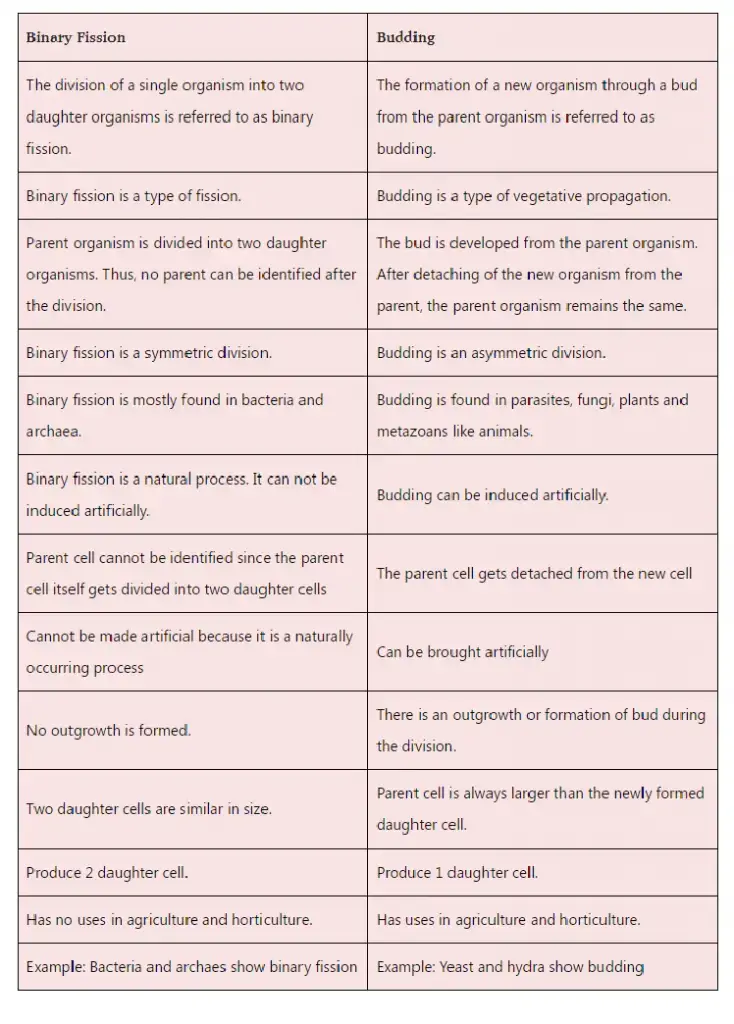Budding and Binary Fission are two different forms of asexual reproduction in fungi and bacteria, and. Binary fission can be present in prokaryotes. Budding can be found in the eukaryotes. The primary difference between binary fission as well as budding is that, during binary fission, the parent organism is split into two daughter organisms through equally separating the cytoplasm. In contrast budding occurs when the new organism emerges from the existing one through the sprouting of.
Contents
Difference Between Binary Fission vs Budding

What is Binary Fission?
The split of an individual organism into two daughters is known in binary fission. Most commonly, prokaryotes, such as archaea and bacteria exhibit binary fission as a cell division process that is used in the asexual reproduction. Eukaryotic organelles such as mitochondria exhibit binary fission through the increase of the amount of organelles within the cell.
Mechanism of Binary Fission
Replication of DNA happens as the initial step that takes place in the process of binary fission. The uniconcircle chromosome of bacteria that was tightly wound prior the replication process, is uncoiled and is subject to replication. Two replicated chromosomes are moved towards opposite poles. The cell then increases its length. The ribosomes, plasma plasmids and ribosomes increase in numbers. The equatorial plate expands to create a separation of cells that are separated by the plasma membrane. An entirely new cell membrane is formed between the cells that have been separated. This division is referred to as the process known as cytokinesis. The two cells that have formed have an approximate equal amount of plasmids, ribosomes as well as other components that make up the cytoplasm. The cytoplasm’s volume is also roughly the same.
Types of Binary Fission
- Irregular Binary Fission: Cytokinesis occurs in the plane perpendicular to the plane on which the karyokinesis took place. It is evident in ameba.
- Longitudinal Binary Fission: Cytokinesis occurs in the direction of the longitudinal axis. It is seen in Euglena.
- Transverse Binary Fission: Cytokinesis takes place on the transverse line. It can be found in paramecium protozoans.
- Oblique Binary Fission: oblique Cytokinesis occurs in ceratium.
Binary fission can be described as an attack process. The typical E. Coli cell at 37°C splits each 20 min. The entire bacterial population goes through binary fission. Thus, the amount of time taken for one cycle is called the”doubling time. Certain strains, such as Mycobacterium tuberculosis have slower doubling times compared with E. coli.
What is Budding?
Budding is one of the mechanisms employed in the asexual reproduction of yeast that results in an outgrowth resembling a bud. The bud stays with the parent organism until it develops and is then separated from it when mature. It is a a genetically identical to the parent. Saccharomyces, the baking yeast cerevisiae, produces a mother cell and a tiny daughter cell through an asymmetric budding. Asexual reproduction of yeast through budding
Metazoans such as hydra produce Bud-like growths as a result of a cell division at a certain place. Buds develop as tiny organisms, and as they mature, they break away from their parent to develop independently as separate organisms.
Parasites such as Toxoplasma gondii reproduce asexually through internal budding. They create two daughter cells via endodyogeny. Endopolygeny refers to the creation of multiple organisms through internal budding. In viral shedding, it is a type of budding. In horticulture grafting buds of one plant to another is known as budding.
Similarities Between Binary Fission and Budding?
- Budding and binary fission are two different ways of sexual reproduction.
- The methods used produce genetically identical offspring with the genetics parents.
- Both are extremely simple and fast ways to get started.
- Cytokinesis and Mitosis occur in both of these ways.
Key Differences
- Binary fission refers to the division of one mother cell from two cells that are daughter cells while budding is the creation of a complete individual from the parent cell.
- The binary fission process is one of the type of fission while budding is an artificial process similar to vegetative propagation.
- The binary process of fission the daughter cell is distinct in comparison to the cell that is parent however during budding the daughter cell is the same as the parent cell.
- Binary fission can be described as a symmetric division. On the other hand budding is not a an symmetric division.
- Binary fissions are found in paramecium, archaea amoeba, and bacteria. Conversely, budding is frequent in parasites, plants and fungi, yeast metazoans and hydra as well as animals.
- Binary fission can’t be utilized in the process of artificial creation however budding could be employed in artificial processes.
References
- https://pediaa.com/difference-between-binary-fission-and-budding/
- https://www.differencebetween.com/difference-between-binary-fission-and-vs-budding/
- https://old.amu.ac.in/emp/studym/100005850.pdf
- https://www.toppr.com/ask/question/what-is-the-basic-difference-between-binary-fission-and-budding/
- https://www.vedantu.com/question-answer/differentiate-between-fission-and-budding-class-12-biology-cbse-5fc75b962b01962f7a423a03
- https://www.shaalaa.com/question-bank-solutions/differentiate-between-following-binary-fission-budding-asexual-reproduction-asexual-reproduction-in-plant_30261
- https://www.researchgate.net/publication/315619780_Difference_Between_Binary_Fission_and_Budding
- https://www.doubtnut.com/pcmb-questions/differentiate-between-the-processes-of-binary-fission-and-budding-16685
- https://www.doubtnut.com/question-answer-biology/what-is-the-basic-difference-between-binary-fission-and-budding–53721766
- https://mycbseguide.com/questions/54817/
- https://askfilo.com/biology-question-answers/what-is-the-basic-difference-between-binary-fissiocba
- https://edurev.in/question/793664/what-is-the-difference-between-fission-and-budding
- https://biodifferences.com/difference-between-binary-fission-and-budding.html
- https://www.steadyrun.com/differenc-binary-fission-budding
- https://www.difference.wiki/binary-fission-vs-budding/
- https://www.cbsetuts.com/differences-binary-fission-budding/
- https://byjus.com/questions/difference-between-binary-fission-and-budding/
Related Posts
- Difference Between Homologous Chromosomes and Sister Chromatids
- Difference between Monocarpic and Polycarpic Plants
- Differences Between Poisonous and Non-poisonous Snakes
- Differences Between Sensitivity, Specificity, False positive, False negative
- Anabolism vs Catabolism – Differences Between Anabolism and Catabolism










